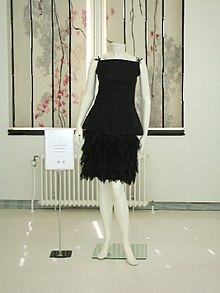Little black dress

The little black dress (LBD) is a black evening or cocktail dress, cut simply and often quite short. Fashion historians ascribe the origins of the little black dress to the 1920s designs of Coco Chanel.[1] It is intended to be long-lasting, versatile, affordable, and widely accessible. Its ubiquity is such that it is often simply referred to as the "LBD".[2][3][4]
The little black dress is considered essential to a complete
History
Black has always been
In 1926
The little black dress continued to be popular through the
The rise of
The generation gap of the 1960s created a dichotomy in the design of the little black dress. The younger "
The popularity of casual fabrics, especially knits, for dress and business wear during the 1980s brought the little black dress back into vogue. Coupled with the fitness craze, the new designs incorporated details already popular at the time such as broad shoulders or
The new glamour of the late 1990s led to new variations of the dress but, like the 1950s and the 1970s, colour re-emerged as a factor in fashion and formalwear and repeatedly shows an aversion to black. The resurgence of body conscious clothing, muted colour schemes, and the reemergence of predominant black, along with the retrospective trends of the 1980s in the late 2000s paved way to the return of interest to the dress.
Famous examples

The black dress worn by Audrey Hepburn as Holly Golightly in the film Breakfast at Tiffany's (1961), designed by Hubert de Givenchy, epitomized the standard for wearing little black dresses accessorized with pearls (together called "basic black"), as was frequently seen throughout the early 1960s. The dress set a record in 2006 when it was auctioned for £410,000, six times its original estimate.[8]
Betty Boop, a cartoon character based in part on the 1920s it girl Helen Kane, was drawn wearing a little black dress in her early films, though with Technicolor later, Betty's dress became red.[6]
Wallis Simpson, Duchess of Windsor, was known to own several little black dresses and said much in praise of the garments. One quote of the Duchess: "When a little black dress is right, there is nothing else to wear in its place."[6]
Édith Piaf, the French folk icon, performed in a black sheath dress throughout her career: for this habit she was nicknamed "little black sparrow". It was thought that the dress helped audiences focus more on Piaf's singing and less on her appearance.[6]
Diana, Princess of Wales wore a black Christina Stambolian dress to the Serpentine Gallery's summer party hosted by Vanity Fair in June 1994, the night her husband Charles, Prince of Wales admitted to having an adulterous affair with Camilla Parker Bowles. Diana's dress has been likened to a "little black dress".[9]
Maria Sharapova wore a "little black dress" during her night matches at the 2006 US Open which she helped design with Nike and featured a round crystal-studded collar after being inspired by Hepburn,[10] and went on to win the tournament. Upon her return to the sport in 2017, eleven years after winning the tournament, she again wore a "little black dress" collaborating with Nike and Swarovski for her night matches at the 2017 US Open to celebrate her return at the championships. The look was intended to be reminiscent of her 2006 dress.
In an incident at London's Covent Garden theatre in 2004, a director fired the then-obese soprano Deborah Voigt from an opera because she could not fit into a "little black cocktail dress", replacing her with the slimmer Anne Schwanewilms.[11][12][13][14]
References
- ISBN 0-19-504465-7.
- ^ styledotcom (2010-08-19). "The LBD Gets Official". Style.com. Retrieved 2013-07-13.
- ^ "Katy Perry looks stunning in slinky LBD". Mirror.co.uk. 2010-04-15. Retrieved 2013-07-13.
- ^ "Women's History Month kicks off in 'Little Black Dress' style", Northern Illinois University Archived 2010-10-11 at the Wayback Machine
- ^ Puhak, Shelley (2017-10-13). "The Underclass Origins of the Little Black Dress". The Atlantic. Retrieved 2020-02-22.
- ^ a b c d Edelman, Amy Holman (1998). The Little Black Dress. Aurum.
- ISBN 9780061963858.
- ^ "Audrey Hepburn's Little Black Dress Sells for a Fortune". Hellomagazine.com. 2006-12-06. Retrieved 2013-07-13.
- ^ Wong, Brittany (June 29, 2018). "The Day Princess Diana And Her 'Revenge Dress' Shocked The World". HuffPost Australia. Retrieved July 7, 2021.
- ^ Wilson, Eric (25 May 2011). "Maria Sharapova's Campaign to Establish Herself as a Brand". The New York Times. Retrieved 5 May 2013.
- ^ Anthony Tommasini, "With Surgery, Soprano Sheds a Brünnhilde Body," New York Times, March 27, 2005, found at New York Times website. Before and after images included. Accessed May 27, 2009.
- ^ Anthony Tommasini, "Second Date With a Little Black Dress," New York Times, June 11, 2008, found at New York Times website. Accessed May 27, 2009.
- ^ Vivien Schweitzer, "Music Review: A Slimmed-Down Diva Keeps Her Vocal Heft," New York Times, June 18, 2009, found at New York Times website. Accessed May 27, 2009.
- ^ "Deborah Voigt: Off The Scales: Opera Star Talks About Lifelong Battle With Weight," found at "Deborah Voigt: Off The Scales, Opera Star Talks About Lifelong Battle With Weight", CBS News. Retrieved May 29, 2009.
Further reading
- Edelman, Amy Holman (1998). The Little Black Dress. Aurum. ISBN 1-85410-604-X.
- "Little Black Dress Transcends Fashion". About.com. May 2006
- "Sixties Fashions". June 2, 2006.
- "The Little Black Dress". Woman's Hour Radio. BBC. May 2006.
- "The Myth Of The Little Black Dress". Jane Curtain . The Fashion Culte Magazine. November 2014.
